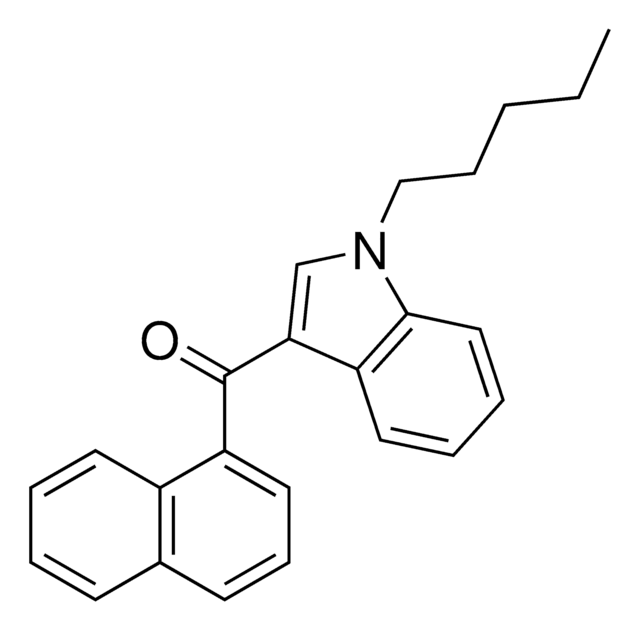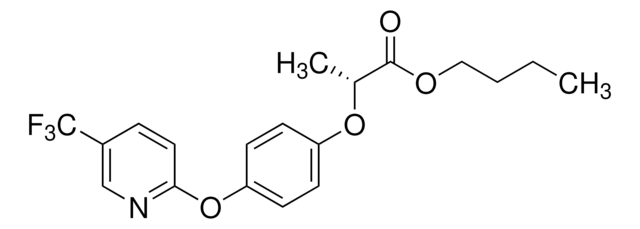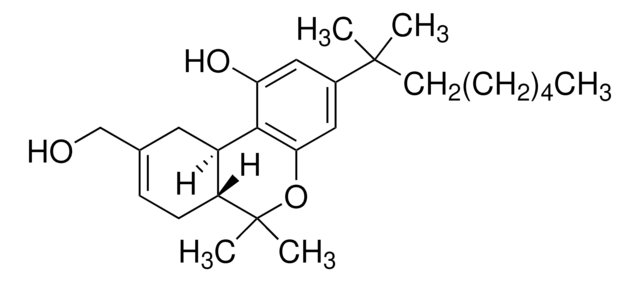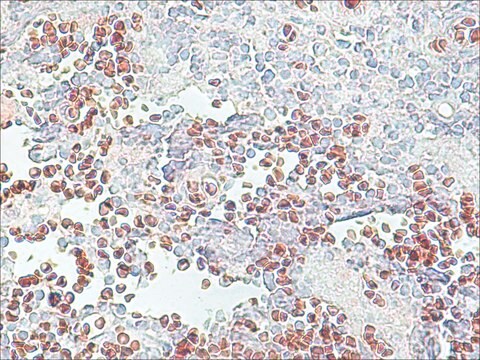推荐产品
生物源
rabbit
品質等級
共軛
unconjugated
抗體表格
affinity isolated antibody
抗體產品種類
primary antibodies
無性繁殖
polyclonal
形狀
buffered aqueous solution
物種活性
human
存貨情形
not available in Japan
技術
immunocytochemistry: suitable
immunohistochemistry (formalin-fixed, paraffin-embedded sections): 8-11 μg/mL
UniProt登錄號
運輸包裝
dry ice
儲存溫度
−70°C
目標翻譯後修改
unmodified
基因資訊
human ... CNR1(1268)
mouse ... Cnr1(12801)
rat ... Cnr1(25248)
正在寻找类似产品? 访问 产品对比指南
一般說明
Cannabinoid receptor type 1 (CNR1) is a G protein-coupled cannabinoid receptor found in central and peripheral nervous system. CNR1 belongs to rhodopsin-like G protein-coupled receptor superfamily.
免疫原
synthetic peptide corresponding to the third cytoplasmic loop of human cannabinoid receptor 1, conjugated to KLH. The immunizing peptide has 100% homology with the rat and mouse gene.
應用
Anti-Cannabinoid Receptor 1 antibody produced in rabbit is suitable for immunocytochemistry and immunohistochemistry using formalin-fixed and paraffin-embedded sections at a concentration of 8-11μg/mL.
生化/生理作用
CNR1 has implications in several disease states, including drug addiction, anxiety, depression, obesity, and chronic pain. Different classes of CNR1 agonists are involved in signaling pathways through the activation of specific subtypes of G proteins. It may play a key role for the treatment of negative affective state produced by alcohol withdrawal and abstinence which is critical for the maintenance of alcohol addiction. CNR1 genes also play some roles in common polymorphism (rs1049353) with potential implications in weight loss.
外觀
Solution in phosphate buffered saline, pH 7.7, containing 0.1% sodium azide.
免責聲明
Unless otherwise stated in our catalog or other company documentation accompanying the product(s), our products are intended for research use only and are not to be used for any other purpose, which includes but is not limited to, unauthorized commercial uses, in vitro diagnostic uses, ex vivo or in vivo therapeutic uses or any type of consumption or application to humans or animals.
未找到合适的产品?
试试我们的产品选型工具.
儲存類別代碼
10 - Combustible liquids
水污染物質分類(WGK)
nwg
閃點(°F)
Not applicable
閃點(°C)
Not applicable
Joong-Youn Shim et al.
The Journal of biological chemistry, 288(45), 32449-32465 (2013-10-05)
The cannabinoid (CB1) receptor is a member of the rhodopsin-like G protein-coupled receptor superfamily. The human CB1 receptor, which is among the most expressed receptors in the brain, has been implicated in several disease states, including drug addiction, anxiety, depression
Jenny Ceccarini et al.
The Journal of neuroscience : the official journal of the Society for Neuroscience, 34(8), 2822-2831 (2014-02-21)
Involvement of the type 1 cannabinoid receptor (CB1R) in the effects of alcohol on the brain is supported by animal experiments, but how in vivo CB1R levels are altered in alcoholic patients is still unclear. To assess the short-time effects
Daniel Antonio de Luis et al.
Journal of investigative medicine : the official publication of the American Federation for Clinical Research, 62(2), 324-327 (2013-12-11)
A polymorphism (1359 G/A) of the cannabinoid receptor 1 (CNR1) gene was reported as a common polymorphism (rs1049353) with potential implications in weight loss. We decide to investigate the role of this polymorphism on metabolic changes and weight loss secondary
Xue Shen et al.
BioMed research international, 2019, 5468954-5468954 (2019-02-26)
Adenomyosis is a common gynecologic benign disease that may have a life-long negative impact on women. Previous studies have indicated that the endocannabinoid system may participate in the progress of endometriosis. Our research aims to analyze the expression patterns of
Xian-Dong Meng et al.
International journal of clinical and experimental pathology, 7(6), 2825-2837 (2014-07-18)
Cannabinoid type 1 receptor (CB1R), which is traditionally located on axon terminals, plays an important role in the pathology of epilepsy and neurodegenerative diseases by modulating synaptic transmission. Using the pilocarpine model of chronic spontaneous recurrent seizures, which mimics the
我们的科学家团队拥有各种研究领域经验,包括生命科学、材料科学、化学合成、色谱、分析及许多其他领域.
联系技术服务部门








